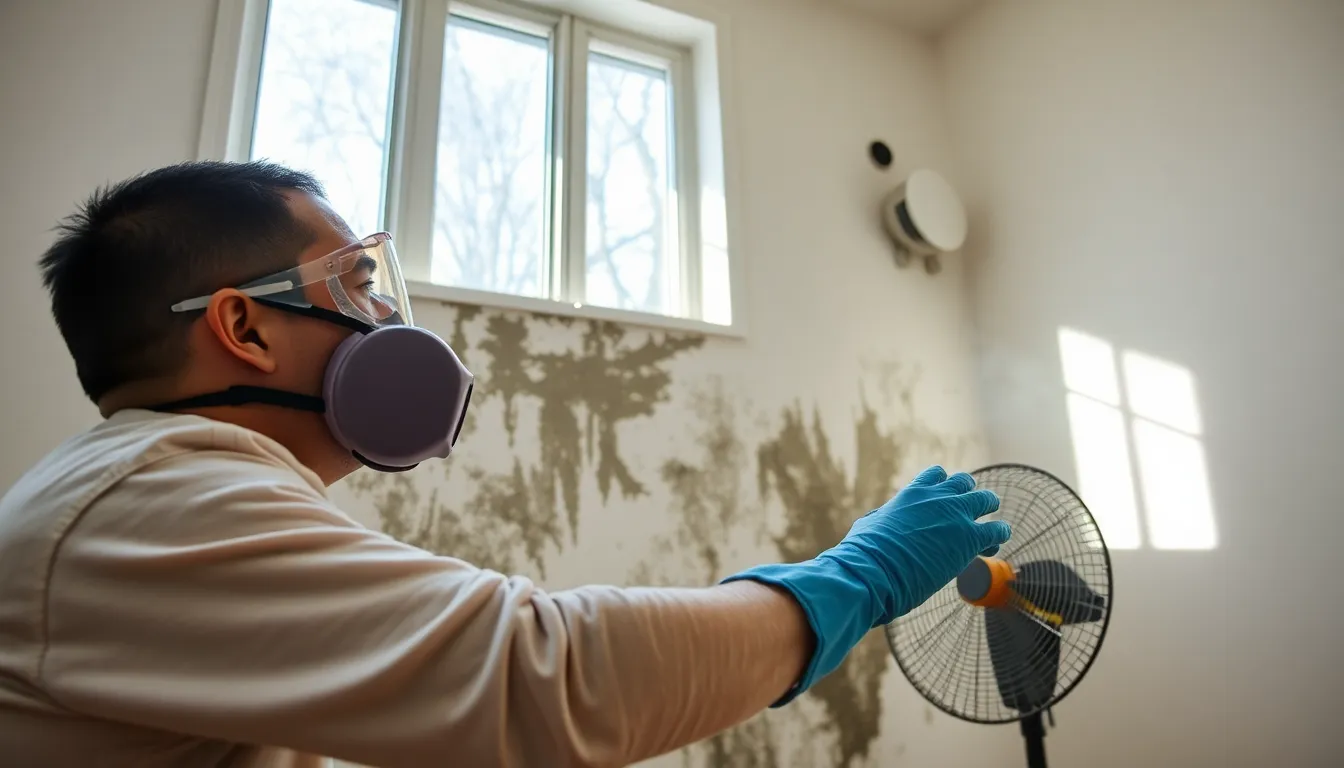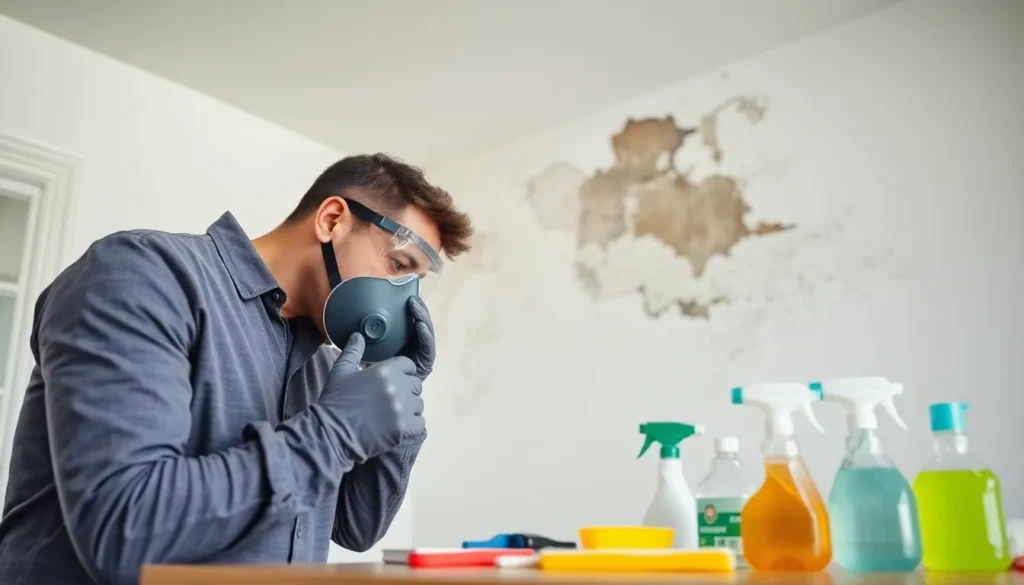Mold on drywall is like that uninvited guest who overstays their welcome—awkward, annoying, and potentially harmful. If you’ve spotted those unsightly black patches creeping up your walls, it’s time to take action. Not only can mold ruin your home’s aesthetic, but it can also pose health risks. So let’s kick that mold to the curb and reclaim your walls!
Table of Contents
ToggleUnderstanding Mold on Drywall
Mold on drywall poses serious risks both structurally and health-wise. Recognizing the types of mold and understanding their causes is essential for effective treatment.
Types of Mold Common in Drywall
Aspergillus presents commonly in many homes. This mold appears in various colors and can impact respiratory health. Cladosporium thrives in damp conditions. It can often found on surfaces in bathrooms or kitchens. Stachybotrys chartarum, known as black mold, has a dark appearance and can produce mycotoxins, creating serious health concerns. Each type of mold has unique characteristics, but all require prompt attention to prevent further growth.
Causes of Mold Growth
Excessive moisture creates an ideal environment for mold growth. It often results from leaks, high humidity levels, or inadequate ventilation. Flooding incidents can contribute significantly to mold problems. Condensation on cold surfaces can also lead to mold development. Lack of maintenance in homes increases risks as well; cleaning and repairs help diminish moisture buildup. Addressing these factors is crucial for preventing mold on drywall.
Safety Precautions

Mold removal from drywall requires careful precautions to ensure safety. Following specific guidelines helps prevent health risks during the cleaning process.
Protective Gear
Wear protective gear to shield against mold exposure. Use N95 respirators to filter airborne spores effectively. Don gloves made of waterproof material to protect hands from mold contact. Consider wearing goggles to safeguard eyes from irritants. Resources like the Occupational Safety and Health Administration (OSHA) emphasize the importance of proper protective equipment.
Ensuring Proper Ventilation
Ensure proper ventilation to minimize inhalation of mold spores. Open windows and doors to create airflow throughout the affected area. Use fans to circulate air and direct spores outside. Dehumidifiers can help reduce moisture, making the environment less conducive to mold. Sources like the Environmental Protection Agency (EPA) recommend maintaining indoor humidity levels below 60%. Following these ventilation tips provides a safer environment while addressing mold issues.
Steps to Treat Mold on Drywall
Addressing mold on drywall involves several critical steps that ensure effective treatment and restoration. Each phase requires careful attention to detail.
Assessing the Damage
Assess the extent of mold growth on the drywall. Inspect both visible and hidden areas for discoloration or dampness. Use a moisture meter for precise readings. Determine if the drywall is structurally sound. If damage extends deeper than surface level, consider replacing sections. Identifying the severity of the issue aids in planning a comprehensive remediation approach.
Removing Mold with Cleaning Solutions
Utilize effective cleaning solutions for mold removal. A mixture of water and dish soap suffices for light infestations. For more resilient mold, a solution of one cup of bleach per gallon of water works. Apply the cleaning solution with a spray bottle or sponge. Scrub the affected area thoroughly to penetrate the mold. Dispose of contaminated materials and clean tools afterward to prevent further contamination.
Drying the Affected Area
Drying the area thoroughly prevents mold from returning. Open windows to increase ventilation. Use fans to promote airflow in affected spaces. Dehumidifiers effectively reduce moisture in the air, maintaining levels below 60%. Ensure the drywall dries completely, which may take several days. Inspect periodically for any signs of moisture before proceeding to repairs.
Repairing and Repainting
Repair any damaged drywall after confirming it’s dry. Patch small holes with joint compound or replace larger sections as needed. Sand any rough areas before painting. Choose a mold-resistant primer to prevent recurrence. Follow with paint that contains mold-inhibiting properties. This step not only restores appearance but also reinforces protection against future issues.
Preventing Future Mold Growth
Preventing mold growth on drywall requires vigilance and proactive measures. Maintaining optimal indoor conditions is essential for a mold-free home.
Maintaining Indoor Humidity
Humidity levels must remain below 60% to inhibit mold growth. Utilizing dehumidifiers helps achieve this by removing excess moisture from the air. Indoor plants also contribute to humidity levels, so consider their placement. Checking bath and kitchen areas frequently for moisture issues is advisable. Using exhaust fans during cooking and showering aids in reducing humidity levels further. Regularly monitoring humidity levels with a hygrometer promotes a healthy environment.
Regular Inspections
Inspecting walls and ceilings regularly ensures early detection of any mold growth. Look for visible signs of mold, such as discoloration or a musty odor. Checking for leaks around windows, roofs, and plumbing helps identify potential moisture sources. Conducting seasonal checks, especially after heavy rain or snow, is beneficial. Observing changes in wall texture can signal water damage that fosters mold growth. Prioritizing these inspections prevents mold issues from escalating, safeguarding both health and property.
Addressing mold on drywall is crucial for maintaining a healthy living environment. Taking swift action not only protects the integrity of the home but also safeguards the health of its occupants. By employing the right cleaning methods and safety precautions, individuals can effectively tackle mold issues.
Regular maintenance and monitoring are key to preventing future mold growth. Staying vigilant about humidity levels and promptly addressing leaks can make a significant difference. With the right approach, homeowners can ensure their spaces remain mold-free and safe for everyone.




